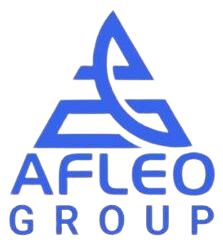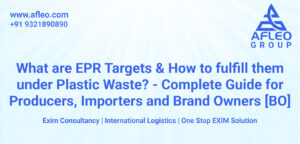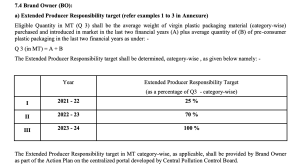In this blog, we will delve into EPR Targets that are assigned to Producers, Importers, and Brand Owners. We will explain how EPR targets for plastic waste are calculated, the logic behind them, the different types of targets, ways to fulfill these targets, and the consequences if the targets are not met. This is a crucial blog, so please read it until the end.
Understanding the Flow of Plastic Packaging Waste in our Society
To understand EPR (Extended Producer Responsibility) targets, it’s essential to first comprehend the flow of plastic waste. This means understanding where plastic packaging originates and how it eventually becomes plastic waste.
There are two main categories that introduce Plastic Packaging into the market and they are: Producers and Importers.
Producers are companies involved in the manufacturing and supply chain of plastic packaging.
Importers are companies that either directly import plastic packaging or use plastic as packaging to protect their products.
These Producers and Importers introduce plastic packaging into the market, typically selling it to Brand Owners (BO). Brand Owners then sell the packaged products to consumers. After consumers use the products, the plastic packaging often ends up in the trash or is improperly disposed of, contributing to plastic waste that is not properly collected or recycled, harming the environment.
For example, when we purchase a packet of chips from the market, the packaging for those chips would have been manufactured by a Producer. The chips’ Brand Owner would have purchased this packaging from the Producer. As consumers, we buy the chips from the Brand Owner, and once we finish consuming the chips, we often dispose of the packaging in the trash or improperly, which leads to it becoming plastic waste. Unfortunately, not all of this plastic waste is collected and recycled, which harms the environment. This is a common scenario that highlights the need for responsible management of plastic packaging and waste.
Keeping this concept in mind, we will now explain how targets are defined for Producers, Importers, and Brand Owners in the following sections.
[If You have still not applied for EPR Registration and are confused whether your Company requires it or not, Please check our blog on this, which also explains the entire process of Registration on CPCB Portal – Who needs EPR registration and What is the Process?]
EPR Target for Producers under Plastic Waste Management Rules
EPR Targets for Producers under Plastic Waste Management Rules
In the image, you can see how EPR targets for Producers are calculated:
The formula to determine the target is (A + B) – C [Please Note that C is not visible in the Image]
Here, A represents the average weight of plastic packaging material (category-wise) sold in the last 2 Financial Years.
Definition of Pre-consumer Plastic Waste
B represents the average quantity of Pre-consumer Plastic waste in the last two Financial Years. The image provides a definition of Pre-consumer Plastic waste, which is self-explanatory.
C is a crucial factor. It represents the annual quantity supplied to Brand Owners and Registered Producers in the previous Financial year.
This means that Producers are assigned a target to recycle as much plastic waste (category-wise) as they have sold, minus what they have supplied to Brand Owners or other registered Producers. In other words, the responsibility for recycling the plastic waste that we sell to registered Brand Owners and Producers is not our own; we can pass that responsibility on. It will be subtracted from our liability as Producers.
Watch the below Youtube video in Hindi in which we will explain how EPR targets for plastic waste are calculated for Producers/Importers & Brand Owners [BO] [PIBO’s], the logic behind them, the different types of targets, ways to fulfill these targets, and the consequences if the targets are not met.
EPR Target for Importers under Plastic Waste Management Rules

In the image, you can see the formula to calculate EPR targets for Importers under Plastic waste:
The formula to determine the target is (A + B) – C
Here, A represents the average weight of plastic packaging material and/or plastic packaging of imported products (category-wise) imported and sold in the last 2 Financial Years.
B represents the average quantity of Pre-consumer Plastic waste in the last two Financial Years.
C is a crucial factor, which represents the annual quantity supplied to Brand Owners in the previous Financial year.
This means that for Importers as well, the liability can be transferred to registered Brand Owners, and the quantity supplied to them (C) is subtracted from the Importers’ liability. Please note that these targets are to be fulfilled in metric tons (MT) and category-wise for each Financial Year while filing the Annual Report.
EPR Target for Brand Owners [BO] under Plastic Waste Management Rules
EPR Targets for Brand Owners [BO] under Plastic Waste Management Rules
For Brand Owners (BO), unlike Producers and Importers, the formula for determining the EPR Target is simplified to just A + B, as shown in the image.Here, A represents the Average Weight of Virgin Plastic packaging material (category-wise) purchased and introduced in the market in the last two Financial Years.
B represents the average quantity of Pre-consumer plastic packaging in the last two Financial Years.
As discussed earlier, once the plastic packaging leaves the Brand Owners and goes to consumers, Brand Owners cannot transfer any liability further. Therefore, Brand Owners cannot pass on any liability, and their responsibility is directly tied to the total quantity resulting from A + B. Brand Owners are required to recycle this quantity category-wise annually and procure EPR certificates/Credits before filing the Annual report.
Smarter Shipping Begins Now – Discover Our Complete Digital Freight Platform.
EPR Target Comparison for all categories
The table below provides a brief comparison of EPR targets for Producers, Importers, and Brand Owners.
It’s important to highlight that the obligation can be transferred to registered PIBOs (Plastic Waste Processors) in the case of Producers and Importers only; Brand Owners cannot transfer their obligation.
EPR targets are a critical subject, and understanding them is essential. Any mistakes or improper use of the provisions can result in an increased target, leading to difficulties in meeting the obligations. Therefore, it’s crucial to have a clear understanding of EPR targets and comply with them accurately.
| Particulars | Producers | Importers | Brand Owners [BO] |
| Definition | Producer means person engaged in manufacture or import of carry bags or multilayered packaging or plastic
sheets or like, and includes industries or individuals using plastic sheets or like or covers made of plastic sheets or multilayered packaging for packaging or wrapping the commodity; |
Importer means a person who imports plastic packaging product or products with plastic packaging or carry bags or multilayered packaging or plastic sheets or like; | “Brand Owner” means a person or company who sells any commodity under a registered brand label or trade mark; |
| Target Obligation | Eligible Quantity in MT (Q 1) shall be the average weight of plastic packaging material (category-wise) sold in the
last two financial years (A) plus average quantity of pre-consumer plastic packaging waste in the last two financial years (B) minus the annual quantity (C) supplied to the entities covered under sub-clause 4 (iii) in the previous financial year as under: – Q 1 (in MT) = (A + B) – C |
Eligible Quantity in MT (Q 2) shall be the average weight of all plastic packaging material and / or plastic packaging
of imported products (category-wise) imported and sold in the last two financial years (A) plus average quantity of pre-consumer plastic packaging in the last two financial years (B) waste minus the annual quantity (C) supplied to the entities covered under sub-clause 4 (iii) in the previous financial years as under: – Q 2 (in MT) = (A + B) – C |
Eligible Quantity in MT (Q 3) shall be the average weight of virgin plastic packaging material (category-wise)
purchased and introduced in market in the last two financial years (A) plus average quantity of (B) of pre-consumer plastic packaging in the last two financial years as under: – Q 3 (in MT) = A + B |
| Transfer of Obligation | Can transfer their Obligation to registered PIBO’s | Can transfer their Obligation to registered PIBO’s | Cannot Transfer |
| Types of target to be fulfilled | ● Obligation of Recycling
● End of Life Disposal ● Obligation for use of Recycled Plastic content. |
● Obligation of Recycling
● End of Life Disposal ● Obligation for use of Recycled Plastic content. |
● Obligation for Reuse.
● Obligation of Recycling ● End of Life Disposal ● Obligation for use of Recycled Plastic content. |
How to fulfill EPR Targets
You might be wondering how to fulfill EPR (Extended Producer Responsibility) targets after understanding what they are.
Actual Look of EPR Targets on CPCB Portal
First, let’s take a look at how your targets are defined on the portal, as shown in the image.
Your EPR targets are defined category-wise, and you are required to fulfill them accordingly.
To fulfill the targets, there are several ways:
- Collect and Exchange: You can collect plastic waste yourself and provide it to a registered Plastic Waste Processor (PWP). In exchange for the collected plastic waste, the PWP will issue you Recycling Certificates for the corresponding quantity.
- Direct Purchase:Another option is to directly contact a registered PWP and purchase recycling certificates for the quantity required to meet your target. This involves a financial transaction.
- Local Authorities:You can also procure recycling certificates from local Gram Panchayats and municipal bodies. These certificates may be available through local waste management programs.
- Certificate Exchange:If there are other registered PIBO’s with excess certificates, you can procure certificates or credits from them.
All of these exchange, transfer, purchase, and sale of certificates or credits occur through the CPCB (Central Pollution Control Board) portal, which is the central platform for managing EPR compliance.
Non-fulfillment of EPR target
According to the polluter pays principle, the CPCB (Central Pollution Control Board) will impose an Environmental Compensation (EC) on PIBOs (Producers, Importers, Brand Owners) if they fail to fulfill their targets on time. This will be a type of penalty. The specific amount of EC will be determined by the guidelines issued by the CPCB.
Paying the EC does not mean that you are not required to fulfill your pending targets. Unfulfilled targets will be carried forward for three years. If a company manages to fulfill its balance target within one year, they will receive a 75% EC refund. If it takes two years to fulfill the balance target, they will receive a 60% refund, and if it takes three years, they will receive a 40% refund. However, if a company still cannot fulfill its balance target after three years, the entire EC amount will be forfeited.
Who are We and How can we help you?
At Afleo Group, we take pride in being India’s No. 1 consultants for EPR (Extended Producer Responsibility) Registration and Compliance, covering various waste categories such as plastic waste, e-waste, battery waste, and waste tires.
We offer comprehensive support at every stage of your EPR journey, including: EPR Registration, Fulfillment of Annual EPR Liability, EPR Portal Management, Access to EPR Credits through our extensive network of Plastic Waste Processors (PWPs), Legal support for EPR Notices and CPCB (Central Pollution Control Board) queries
Our Unique Selling Propositions (USPs) for EPR Compliance:
- Consistent fulfillment of annual EPR Liability within the deadline each year.
- Freedom from dependency on a limited number of waste recyclers for EPR Credits, as we have onboarded a vast network of Plastic Waste Processors (PWPs).
- Offering the best and lowest rates for purchasing EPR Credits to meet your EPR targets.
- Handling annual sales/purchase data filing.
- Efficient EPR Portal Management.
- Providing legal support for CPCB queries or notices.
We are proud to serve over 500 clients in EPR compliance, including producers, importers, and brand owners.
If you have any EPR compliance requirements, please do not hesitate to get in touch with us. Our dedicated team will be delighted to assist you.
Thank you.





